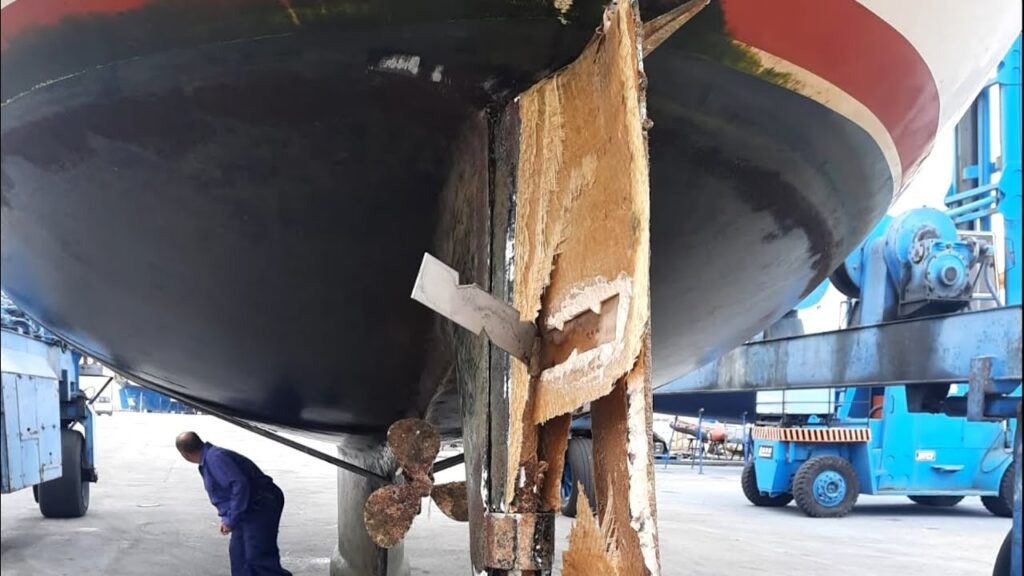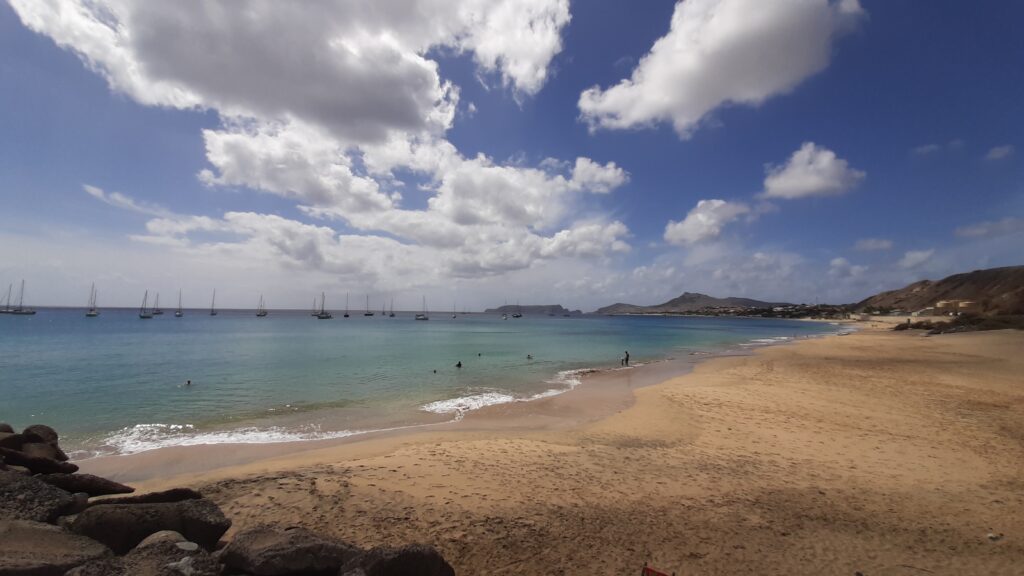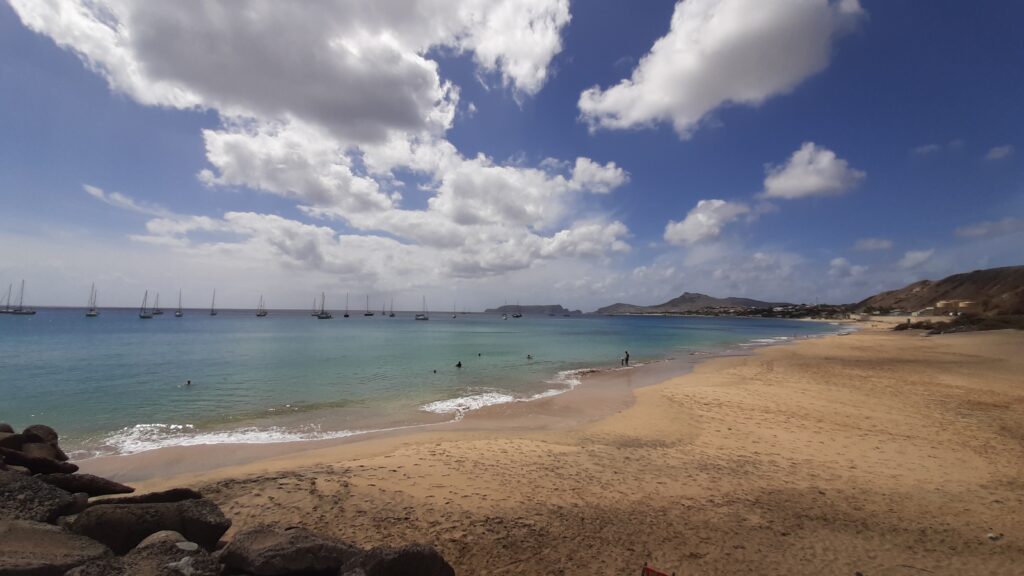So after the Portuguese west coast we arrive at the Portuguese Algarve. It provides gives a mix of experiences: coastal towns full of tourists, large expensive marinas, lots of entertainment, but also beautiful deserted bays and beautiful anchorages. And the latter makes you realize again why you are doing this…
After the trip to Barcelona it is time to prepare for the next bigger crossing: the one to Madeira. That is about 500 miles sailing from the Algarve. In conservative terms, that means continuous sailing for about 5 days. With good wind this can of course be faster, with bad wind it will be more. It is therefore important to have a good “weather window” again: a few days with the right wind and weather conditions. We also have to stock up: enough food and drink to pass the time + some extras just in case, and also some extra diesel if we are forced to motor a larger distance.
In addition to the weather, there is something else on peoples’ minds: orcas. Orcas are found along the Atlantic coast of Spain and Portugal. Their habitat ranges from Gibraltar to Galicia, depending on the season and where their prey fish can be found. Normally that is not a problem and even a real tourist attraction to find and see them. However, since about 1.5 years, a number of orcas show somewhat different behavior: they attack sailing boats and especially boats around 10-15 meters (that is us). They mainly target the rudders of the boats: they ram the boats, ram the rudders, and even bite the rudders off completely. What started with a single incident in spring 2020 has now turned into a fairly regular phenomenon. We also hear of attacks taking place at locations where we have just been the day before ( e.g. here). You can find more information on these sites if you want: https://www.orcaiberica.org/last-interactions and https://www.yachtingworld.com/cruising/orca-attacks-rudder-losses-and-damage-as-incidents-escalate-133968. Or google on “Orca attacks” and you will find all kinds of info…

So that’s not a nice thought. If you are attacked on the ocean by a group of orcas and your boat becomes uncontrollable due to a damaged rudder, or in the worst case even sinks due to additional damage. It is therefore the talk of the town among sailors in Portugal. Especially among those who want to cross to Madeira or the Canary Islands. Some boats agree to sail together, or at least the first 50 miles offshore to get past the greatest danger zone. We are also approached, but in the end it doesn’t come to that: we are going to make the crossing alone.
There seems to be a good weather window approaching: after a quiet start wind all the way between 15 and 20 knots (wind force 4 to 5) from northwest to northeast. Actually perfect. We get ready and on Friday morning, September 17, we let go of the ropes and set sail for Madeira.
The start is promising: a nice running “backstay” wind (diagonally from behind) but it soon disappears (this was predicted), so we turn on the engine to retain some progress. Not much later the wind comes again. However, it is much more westerly than was predicted, so we have to sail almost close to the wind. The wind also increases rapidly: within an hour we have moved from wind force 3 to wind force 5. The wind does turn slightly to the west-northwest, but it won’t get much further than from the side. So, we decide to bear off a little hoping that we can make up for that later when the wind turns further.
By the evening we have completed the first 50 miles and we give each other a high-five in the assumption that we should be out of “Orca-territory” by now. What a relief. We also see dolphins again: and that is also a good sign, because where dolphins are there are no orcas, so we are even happier than usual to see Flipper. We now also cross the busier sailing route towards the Strait of Gibraltar. We do this just outside the official separation system so that we don’t have to cross perpendicular (that is mandatory in such an official separation system, a highway for ships) and we even have priority as a sailing ship over all motor ships, even though we are so small and they so big. It’s a crazy sight to see a huge tanker adjust its course to give us way.
As we go into the night the wind increases even further. Eventually we reach around 25 knots with peaks to 30. So, a wind force 6 to 7. We therefore go into the evening and night with the mainsail on the third reef (smaller is not possible except by completely removing it) and the inner jib partly rolled away. Strong winds also give rougher seas. Eventually, rough enough so No gets seasick. A “Primatour” offers no relief (if only because it is puked out fairly quickly) and the German chewing gum doesn’t work sufficiently either. There is only one thing to do: go to bed and sleep. I stay in the cockpit and do 30 minute naps. After the shipping lane we don’t actually see any other boats anyway.
In the morning things are going a little better, but not quite good enough yet. Time for more rigorous measures: the anti-seasickness plaster. It does work. No recovers and she is okay for the rest of the way. The wind continues to hold up pretty strong; sometimes we take the third reef out for a while, but for the night it goes back in. So, it stays a bit bumpy but we are making good progress: more than 130 miles in 24 hours so we will arrive a bit earlier. At night I am woken up when the windvane controls have come loose: something has broken off due to the rough conditions. In daylight I can make a makeshift repair and for the rest of the trip it works fine again.
It is not before Monday when the wind decreases a bit further and we can set some more sail. Then on Monday at the beginning of the evening the liberating words follow: “Land in sight!”. It is the small island of Porto Santo which is about 30 miles away from Madeira. We decide to sail there to drop anchor. Around midnight we reach the anchorage. After some searching in the dark we find a spot, drop anchor, have an arrival beer and then fall into a deep coma to make up some sleep. We made it: 490 miles in 86 hours (5.7 knots average, not bad), a nice trip but a bit rough.
Porto Santo turns out to be a charming anchorage. A small island (we rent a scooter to cruise around the island), beautiful clear water, a nice bay and not too busy or touristy. We do have to clear customs officially and even provide paper Covid certificates, even though it should be Portugal and therefore EU. It takes some effort, but the border police are the most friendly. Clearance is also necessary when we leave a few days later for the “real” Madeira.
That day comes the bonus: where earlier we were happy to see dolphins next to the boat and where we were especially happy not to see any orcas next to the boat, I now hear a loud “PSSHHHTTT” next to the boat and see a large foam spot in the water. What was that?? Orcas after all? Not much later it becomes clear: a whale!! Right next to the boat, a whale briefly surfaced to breathe. He swims with us for a few minutes, comes up a few more times, swims behind and under the boat, shows us his belly, and a little later goes his own way again. What a beautiful sight. Such a big animal (“as big as the boat” as No exclaims) close to the boat and swimming with us in a relaxed way (it was a so-called Bryde’s whale they later told me in Madeira). This already makes the trip to Madeira more than worthwhile!


Dag Mullie en nobilé. Ik geniet van jullie reisverslag. En dat niet voor de eerste keer. De route 66 was wat, Kaapstad Amsterdam ook. Nu een jaar onder zeil. Ik vind het wat. Ik wens jullie een behouden vaart en wees ervan verzekerd: jullie worden door mij gevolgd.